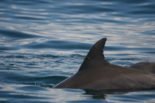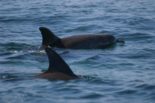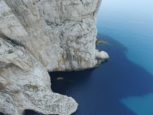The marine protected area
- The coast along the bay of Porto Conte and one of the Spanish towers
- Dolphins at Capo Caccia
- The entrance of the big bay of Porto Conte. In the background Capo Caccia
- Capo Caccia, west coast, and the entrance to the Nereus cave
The tourist centre ArchiMete Sardegna is located in the heart of the Marine Protected Area of Capo Caccia-Isola Piana; a protected reserve created in 2002 with the aim of protecting the natural and faunal heritage, which is unique in the world. Here, in fact, there is the highest concentration of underwater caves in the Mediterranean sea, which were a privileged refuge for monk seals until a few decades ago. Stunning and scenic ravines, rich in underwater flora and fauna, can easily be visited by groups of divers (however, a local diving guide must always be present). The marine area includes the fjord of Porto Conte, which reaches from Punta delle Gessiere on the northern-western side, across to the southern-eastern coast starting at Punta Giglio; ending up at the cape. The area is characterized by imposing chalky capes which rise up from the sea, and which are perfect shelters for birds like the Corsican gull, the Cormorant and the Rare Griffon; a bird which can reach a wingspan of around 3 metres. The marine area is divided into three areas; the “A” area is a full reserve where all activities are forbidden; while in the “B” and “C” areas, transit, diving, snorkeling, and fishing, with the required permit, are allowed.
The creation of the marine protected area meant a real turning point for the repopulation of the entire submarine world of this area.
Fauna: The marine protected area of Capo Caccia-Isola Piana has a fauna heritage which is unique in the world. The geo-morphological characteristics of the territory, specifically cliffs and chalky rocks, encourage the colonies of species such as sponges, lithophagous molluscs, and gorgonians belonging to the Eunicella and Paramuricea clavata species, including the scenic red and violet gorgonian which, in this part of Sardinia, finds its perfect habitat. Also the famous red coral (Corallium rubrum), finds the best conditions to root and grow here, and can easily be spotted in several caves, even at depths which are not so extreme (there are numerous colonies already at 5 metres in depth). A precious resource from a naturalistic standpoint, since coral is a very good environmental indicator; but also for the local economy, which has created a district for the hand-crafted processing of this organism which is unique in the world. This very important and historical element is also represented on the coat of arms of the Municipality of Alghero.
Waters and Caves of the marine protected area are also the perfect habitat for the Mediterranean spiny lobster (Palinurus elephas), companions on every dive in this area; for the red shrimp (Parapandalus narval), and clawed lobsters (Homarus gammarus); and for cicadas (Scyllarides latus) and crabs (Maja squinado). In the meadows of Neptune grass, (Posidonia oceanica) it is easy to spot funny sea horses (Hippocampus) and Pinna nobilis, in addition to cuttlefishes and bottom fishes like gobies, blotched picarels, blennies, marithes, green wrasses and mullets. Instead, the Necton environment offers close encounters with big pelagic fishes such as breams, sea basses, sea breams, groupers, sunfishes, congers and barracudas; the latter is easy to spot when returning from a dive. The protected area of Porto Conte and the steep coast of Capo Caccia are also an irresistible call to big cetaceans, like dolphins and grampus, which are easy to spot early in the morning.
Instead, cliffs and rocks which rise up from the sea, are the privileged refuge of several species of marine birds, like the Corsican gull (Ichthyaetus audouinii), the shag (Phalacrocorax aristotelis), the Cory’s shearwater (Calonectris diomedea), the shearwater (Puffinus puffinus) and the storm petrel (Hydrobates pelagicus).
Flora: The area protected by the Regional Natural Park of Porto Conte presents rich and flourishing greenery, and maquis, which alternate with forests of oaks (Quercus ilex); often rising up from the sea. The underwater world is rich in several species of brown and green algae, while sandy sea beds are dominated by meadows of Neptune grass (Posidonia oceanica). The nearest stretches of coast close to the river, on the contrary, see the flourishing of algae belonging to the Caulerpa and Cymodocea families.















